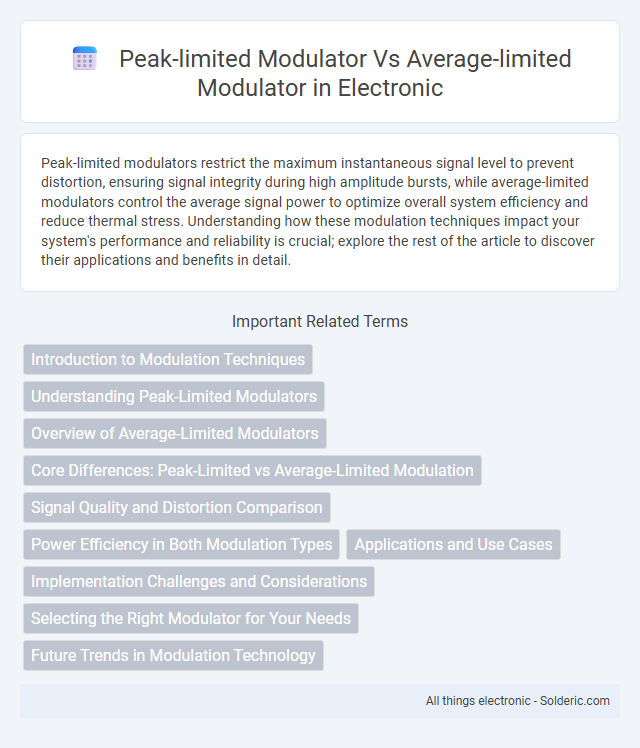Peak-limited modulators restrict the maximum instantaneous signal level to prevent distortion, ensuring signal integrity during high amplitude bursts, while average-limited modulators control the average signal power to optimize overall system efficiency and reduce thermal stress. Understanding how these modulation techniques impact your system's performance and reliability is crucial; explore the rest of the article to discover their applications and benefits in detail.
Comparison Table
| Feature | Peak-Limited Modulator | Average-Limited Modulator |
|---|---|---|
| Definition | Modulator constrained by maximum instantaneous amplitude or peak power. | Modulator limited by average power over time, ensuring long-term power constraints. |
| Power Constraint | Strict peak power limit. | Strict average power limit. |
| Performance Impact | May cause signal distortion to comply with peak limits. | Maintains signal integrity but limits overall transmission power. |
| Use Case | Applications requiring precise peak power control, e.g., RF transmitters to avoid saturation. | Systems where thermal or regulatory average power limits are critical, e.g., cellular base stations. |
| Complexity | Moderate complexity due to instantaneous peak detection. | Higher complexity for accurate long-term power measurement and control. |
| Energy Efficiency | Potentially less efficient due to strict peak clipping. | More energy efficient over time within regulated power limits. |
Introduction to Modulation Techniques
Peak-limited modulators constrain the signal amplitude to avoid distortion and ensure transmitter linearity, optimizing power efficiency in communication systems. Average-limited modulators regulate the average power over time, balancing signal quality and energy consumption for long-term stability. Your choice between these techniques impacts system performance, especially in scenarios demanding precise power control and signal integrity.
Understanding Peak-Limited Modulators
Peak-limited modulators limit the instantaneous amplitude of the signal to prevent distortion and clipping while maintaining signal integrity, crucial in applications requiring strict control over maximum signal peaks. Understanding the difference between peak-limited and average-limited modulators helps optimize your system's performance, as peak-limited types prioritize avoiding signal peaks above a threshold rather than controlling long-term average power. This makes peak-limited modulators ideal for scenarios with strict amplitude constraints, such as in communications and audio processing where signal peaks can cause non-linear distortion.
Overview of Average-Limited Modulators
Average-limited modulators regulate the output signal based on the average power rather than the instantaneous peak power, improving overall efficiency in communication systems. These modulators enable higher average transmitted power while maintaining signal integrity, which is crucial for reducing signal distortion and improving spectral efficiency. Compared to peak-limited modulators, average-limited designs support more consistent power delivery and better manage nonlinearities in power amplifiers.
Core Differences: Peak-Limited vs Average-Limited Modulation
Peak-limited modulators restrict the maximum instantaneous amplitude of the signal, ensuring the output stays within a predefined peak threshold to prevent distortion or clipping. Average-limited modulators, on the other hand, regulate the signal based on average power or energy over time, optimizing performance for systems sensitive to long-term power constraints. These core differences influence the choice of modulation in communication systems, with peak-limited designs prioritizing signal fidelity under sudden peaks and average-limited designs focusing on power efficiency and thermal management.
Signal Quality and Distortion Comparison
Peak-limited modulators restrict the maximum amplitude of the signal to prevent clipping, resulting in lower peak distortion but potentially higher average distortion due to signal compression. Average-limited modulators manage the overall power more evenly, which can preserve signal fidelity and reduce average distortion but may allow occasional peaks that introduce instantaneous clipping. Your choice between these modulators affects the balance between signal quality and distortion, depending on whether peak amplitude or average power control is more critical for your application.
Power Efficiency in Both Modulation Types
Peak-limited modulators constrain signal peaks to prevent distortion, enhancing linearity but often reducing power efficiency due to conservative power back-off. Average-limited modulators allow higher peak signals by controlling the average power, improving power efficiency but risking increased distortion and nonlinearities. Understanding your application's power efficiency requirements helps determine the optimal modulation type for balancing signal quality and energy consumption.
Applications and Use Cases
Peak-limited modulators excel in applications requiring strict instantaneous signal control, such as high-frequency radar systems and satellite communications, where preventing signal distortion and interference is critical. Average-limited modulators are preferred in power amplifier efficiency optimization and wireless base stations, balancing signal quality with thermal management and long-term power constraints. Both modulator types play essential roles in advanced telecommunications infrastructure, tailored to specific regulatory and operational requirements.
Implementation Challenges and Considerations
Peak-limited modulators require precise control circuitry to avoid signal distortion caused by exceeding instantaneous power thresholds, posing challenges in real-time dynamic range management. Average-limited modulators focus on maintaining signal power within average levels, necessitating sophisticated feedback loops and thermal management to prevent long-term component degradation. Both implementations must address trade-offs between linearity, efficiency, and complexity, impacting system stability and design scalability.
Selecting the Right Modulator for Your Needs
Choosing between peak-limited and average-limited modulators depends on application requirements such as signal distortion sensitivity and power efficiency. Peak-limited modulators prioritize controlling maximum amplitude peaks, reducing saturation and nonlinear distortion in high peak-to-average power ratio signals. Average-limited modulators focus on maintaining consistent average power output, optimizing thermal performance and efficiency in continuous wave or constant envelope transmissions.
Future Trends in Modulation Technology
Future trends in modulation technology emphasize the shift from average-limited modulators to peak-limited modulators due to their superior efficiency in handling high peak-to-average power ratios, essential for modern communication systems. Peak-limited modulators enable improved signal quality and power efficiency in 5G and beyond, supporting higher data rates and reduced latency. Your choice of modulator will increasingly impact network performance, energy consumption, and the scalability of emerging wireless technologies.
Peak-limited modulator vs average-limited modulator Infographic

 solderic.com
solderic.com